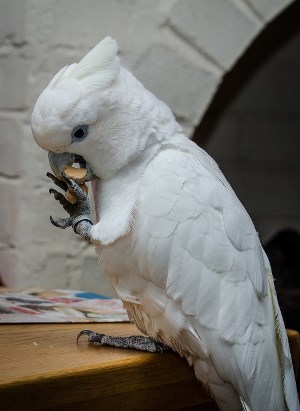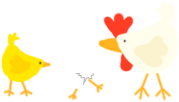Paukščiai mene

Aprašymas angliškai, nes neturiu laiko versti.
Henry Stacy Marks took a particular interest in the painting of birds, and A Select Committee is possibly his best-known painting, though the 12 bird panels which he produced for Hugh Grosvenor, the 1st Duke of Westminster, are also well-known. Most of his bird paintings are watercolours and many were exhibited at the Old Watercolour Society or at the Fine Art Society. A Select Committee was painted in 1891 and now hangs in the Walker Art Gallery in Liverpool. It is a colourful portrayal of a gathering of parrots, wittily satirising parliamentary meetings of the time. Marks was passionate about birds, which he referred to as creatures second only to women in beauty, of such gorgeous colour and form. This painting is a good example of Stacy Marks frequent anthropomorphism, or tendency to give non-human beings human characteristics.
-

sailor - Pranešimai: 22581
- Užsiregistravo: 2007.02.21 23:18
- Miestas: Kaimas Airijos vidury
- Augintiniai:
Šitas piešėjas - Henry Stacy Marks - buvo 19 šimtmečio anglų dailininkas, piešė daug ką, bet ypač mėgo tapyti įvairus paukščius, ne tik papūgas.
http://www.bbc.co.uk/arts/yourpaintings/artists/henry-stacey-marks/
http://www.artnet.com/artists/henry+stacy-marks/past-auction-results
Šitame paveiksle papūgų susirinkimu satyriškai pavaizduotas to meto Britanijos parlamento sueigos.
Dailininkas labai mėgo paukščius ir dažnai juos apibūdindavo kaip antrus pagal grožį padarus po moterų (matau, gede prijaus tokiai dailininko nuomonei ).
).
http://www.bbc.co.uk/arts/yourpaintings/artists/henry-stacey-marks/
http://www.artnet.com/artists/henry+stacy-marks/past-auction-results
Šitame paveiksle papūgų susirinkimu satyriškai pavaizduotas to meto Britanijos parlamento sueigos.
Dailininkas labai mėgo paukščius ir dažnai juos apibūdindavo kaip antrus pagal grožį padarus po moterų (matau, gede prijaus tokiai dailininko nuomonei
 ).
).-

sailor - Pranešimai: 22581
- Užsiregistravo: 2007.02.21 23:18
- Miestas: Kaimas Airijos vidury
- Augintiniai:
Antro šimtmečio prieš mūsų erą mozaika - Aleksandro žieduotoji papūga

Paaiškinimas angliškai:
Hellenistic mosaic floor panel of an Alexandrine parakeet from Pergamon, 2nd century BC, Pergamon Museum
The species Alexandrine parakeet or Alexandrian parrot (scientific name Psittacula eupatria, noble fatherland or of noble ancestry) is named after Alexander the Great, who is said to have first sent several of the birds from the Punjab to the west, where they became popular as exotic pets of rich and noble families.
The Hellenistic mosaic floor panel, made in Pergamon around the middle of the 2nd century BC (the time of Eumenes II and Attalus II), was taken from the "altar room" of Palace V of the Pergamon Acropolis.
The type of mosaic found in some of Pergamon's ancient buildings is known as opus vermiculatum (Latin, worm-like work), a technique invented in Greece, in which images are made of rows of coloured tesserae (small cube-shaped pieces of stone, and later also of glass). The subtle colouring of the mosaics imitated painting. Individual motifs, including mythical figures, animals and plants were surrounded by dark tesserae, which highlight the vibrant colours. Often, outlines marked by rows of tessarae were used as contours or to further heighten the pictorial effect, as in drawing. This mosaic artist has used only colour and tone for his subject in a painterly manner, resembling trompe l'oeil realism.

Paaiškinimas angliškai:
Hellenistic mosaic floor panel of an Alexandrine parakeet from Pergamon, 2nd century BC, Pergamon Museum
The species Alexandrine parakeet or Alexandrian parrot (scientific name Psittacula eupatria, noble fatherland or of noble ancestry) is named after Alexander the Great, who is said to have first sent several of the birds from the Punjab to the west, where they became popular as exotic pets of rich and noble families.
The Hellenistic mosaic floor panel, made in Pergamon around the middle of the 2nd century BC (the time of Eumenes II and Attalus II), was taken from the "altar room" of Palace V of the Pergamon Acropolis.
The type of mosaic found in some of Pergamon's ancient buildings is known as opus vermiculatum (Latin, worm-like work), a technique invented in Greece, in which images are made of rows of coloured tesserae (small cube-shaped pieces of stone, and later also of glass). The subtle colouring of the mosaics imitated painting. Individual motifs, including mythical figures, animals and plants were surrounded by dark tesserae, which highlight the vibrant colours. Often, outlines marked by rows of tessarae were used as contours or to further heighten the pictorial effect, as in drawing. This mosaic artist has used only colour and tone for his subject in a painterly manner, resembling trompe l'oeil realism.
-

sailor - Pranešimai: 22581
- Užsiregistravo: 2007.02.21 23:18
- Miestas: Kaimas Airijos vidury
- Augintiniai:
-

sailor - Pranešimai: 22581
- Užsiregistravo: 2007.02.21 23:18
- Miestas: Kaimas Airijos vidury
- Augintiniai:

Walter Howell Deverell - The Grey Parrot
1852-1853
Paveikslas yra Viktorijos meno galerijoje Melburne.
-

sailor - Pranešimai: 22581
- Užsiregistravo: 2007.02.21 23:18
- Miestas: Kaimas Airijos vidury
- Augintiniai:
-

sailor - Pranešimai: 22581
- Užsiregistravo: 2007.02.21 23:18
- Miestas: Kaimas Airijos vidury
- Augintiniai:
Grįžti į Plunksnuočių nuotraukos ir video
Dabar prisijungę
Vartotojai naršantys šį forumą: Registruotų vartotojų nėra ir 13 svečių






